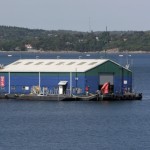On Saturday March 15th, 19 curious people gathered in Amherst to learn the art, science and skills associated with inoculating a pre-cut hardwood host log with spawn of the shiitake mushroom. The workshop was hosted by Athol Forestry Cooperative and the Ecology Action Center.
The workshop facilitator was Gavin Hardie of Bay Of Fungi located in Sackville, NB.
Shiitake, meaning “mushroom of the shii, or oak tree” in Japanese, is highly prized in the Orient for its flavor and reputed medicinal value. It is a major agricultural commodity in Japan, where about half the world’s supply of shiitake mushrooms is produced, primarily on an artisanal scale.
Of the common Acadian forest species, sugar maple, red maple, grey and white birch are the best suited for propagation of shiitakes. Conifer species are not suitable for propagation of shiitake mushrooms in part because the resin contained within them tends to be fungicidal.
We all made quick work drilling holes in our assigned logs, driving in the inoculated plugs provided and then sealing the wounds made by the drilling and pounding, with melted beeswax.
Once inoculated in this fashion, the logs are to be stored outside, off the ground in a shaded area. Gavin stated that the shade of a conifer tree(s) is ideal as they provide even shade year round and the soil and detritus on the ground is less likely to harbor strains of fungus that compete with shiitake mycelium. Mine is stored behind our garden shed, layed horizontal on a couple of old bricks, under a giant white spruce where it will rest for the next 8 months sheltered from direct sunlight and drying winds. At that time, the shiitake mycelium should have fully colonized the log, evident by the fuzzy white at the cut ends of the log. A change in moisture will induce ‘fruiting’, or the production of the edible shiitake mushrooms so prized for their flavor and medicinal benefits.
Here is a good internet link for more info.:
http://www.gmushrooms.com/Plugs/SmallScaleShiitakeProduction.pdf
Bay of Fungi does not have a website as of yet, but can be contacted at: bayoffungi@gmail.com
Blog written by Su Morin, Community Food Programmer (Cumberland), for the Ecology Action Centre.
Photo: Courtesy of Andrew Hinners



